#Telesterion
Text
We will let you worship our feet after school
Kayla Kayden In Make Me Sweat
Stressed out MILF with a SEXY body gets a happy ending massage
VRHUSH Naughty threesome with Richelle Ryan and Lala Ivey
Chubby mature gets both holes fucked in a threesome
Sharing a Bed with My Step Mom and She Dares Me Not to get Hard - Nikki Brooks
Busty alt blonde in different bdsm devices
My favorite Renamon Animation
seios enorme dessa gata do swing
Big Natural Tits Blonde Lena Paul Fucks a BBC Interracial
#monumentary#paca-rana#tolled#ringleted#graphitize#zechins#Nietzscheanism#apathaton#workaday#Calvinistical#teleblem#porch#telesterion#world-encircling#Machiavellianly#brolly-hop#unseemliness#recoupment#outfawned#canny
0 notes
Text
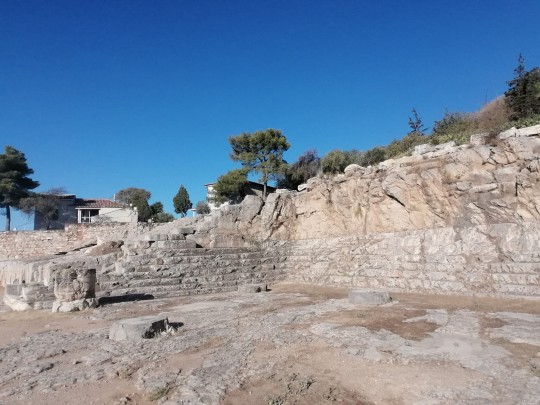

The Telesterion, Eleusis.
Still can't believe we got to see the sanctuary at Eleusis by ourselves with no one else there. It felt like a blessing of Demeter to just stand there in the center of the grounds, walk through the museum, pray and leave our offerings in silence without the clamor and intrusion of other tourists. Bless the Great Goddesses, may I one day find my feet entering her sacred grounds again.
17 notes
·
View notes
Text
Choose Your Fighter, Ancient Greek Mystery Cult Edition:
The Eleusinians:
Harvest Rites: Eleusinian units gain a small damage buff from consuming wheat and wheat based products.
Pan-Helenic: The Eleusinians may recruit from any city state.
Telesterion: Eleusinian mystery rites may be performed en-masse. All surviving members will be instantly upgraded to initiates.
Kykeon: Initiates may consume kykeon to temporarily induce Mystical Frenzy.
The Pythagoreans:
Mendicant: Pythagoreans do not require permeant structures to recruit new units.
Metempsychosis: Pythagoreans initiate units may reincarnate as dogs.
Pythagorean Arete: Pythagoreans cannot perform blood sacrifices, but only require vegetables to survive. Pythagoreans have -50% resistance to bean damage.
Tetractys: Your influence on Plato allows you to start the game with +150% clout.
The Orphics:
Zagrean-Baccic Rites: Female units deal +200% extra damage with Frenzied Dismemberment.
Theogony: Orphics can modify their cosmology depending on the locale.
Orphic Katabasis: Upon death, Orphic initiates may invoke the furies.
Rites of Phanes: Transgender orphic units gain +200% clout when they are playing music.
564 notes
·
View notes
Text

The Ploutonion in Eleusis.

I think this was one of the very few times i visited an ancient site with such obvious offerings. There's a pit in front of the cave that had primarily pomegranates thrown inside along with what looked like some crop? Wheat? I'm not sure. And in the small (but surprisingly deep) opening on the cave wall there were tons of stuff thrown in that my phone refused to capture 🥹.

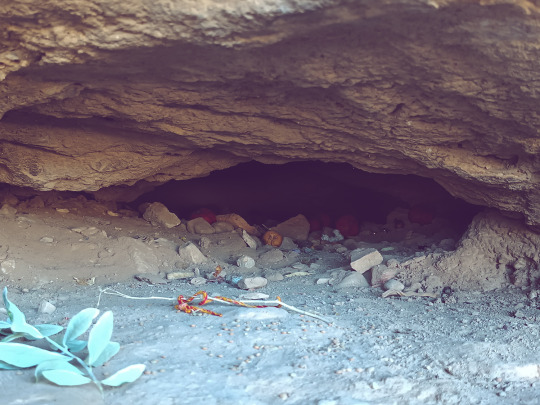
I think it was also the only time i have seen so many pagan visitors at a site, obviously praying. I also saw people washing themselves in the sea (and i say that because they wore veils, were dressed and very obviously ritualistically washed their arms and legs). Which brings me to my next point of, probably doing this once won't be a problem, but i would not recommend you do anything like try and swim in the sea below eleusis, and if you have any skin issues maybe avoid extended contact with it. It is very, very polluted.
Oh and i kinda felt bad for the group of visitors who were trying to sit outside the telesterion peacefully with their eyes closed, because literally just outside the site they were giving the award ceremony for the historic acropolis rally and there was lots of speaking through loudspeakers and old car engines going crazy.
#ancient greek mythology#hades#Persephone#next post will have my beloved Antinous who keeps popping up where you least expect him 😌🫶
98 notes
·
View notes
Text
"Athena's name may appear in the Linear B tablets and many believe that she began as a Bronze Age goddess, derived from the Minoan goddess with snakes (conventionally termed a household goddess'), and later became a goddess associated with the Mycenaean palaces. Her function as protectress of the polis may be seen as an extension of her Bronze Age function as protectress of the household. Bronze Age depictions of the household goddess with birds and snakes are paralleled in the historic period, when Athena is portrayed with owls and snakes. There is no evidence that she was armed in Minoan art but a case could be made for the existence of an armed goddess in the Mycenaean period. Some argue that she is an ancient, indigenous goddess, connected with weaving, whom the Indo-European Greek-speaking peoples encountered when they came into the Greek peninsula. It is unclear whether the city of Athens was named after the goddess, or if Athena took her name from the city, though the latter is more likely. In either case, her name must have come into prominence during the Mycenaean period in Athens. In Athena's Panhellenic image, her role as armed protectress of the city is paramount — clearly more important than other significant attributes, such as a goddess of crafts, technology, wisdom, and fertility of the olive. In myth, Athena is depicted as a virgin goddess, born from her father's head; she is generally perceived to be very masculine in her traits. In cult, however, the evidence from some sites, such as at Tegea and Gortyn on Crete, indicates she also was a fertility goddess and aMistress of Animals', and that she was especially important to her female worshippers. It is interesting to note that in Athens, Athena's masculine traits became increasingly emphasized over time; it is argued that such a male image of the goddess was deliberately expressed in the sculptural programme of the Parthenon, in order to justify having a female as Athens' paramount deity.
It is notable that some of the earliest temples known in the Greek world were dedicated to Hera on the island of Samos and at Perachora. In the Argolid, the most powerful region of Mycenaean Bronze Age culture, the cult of Hera is pre-eminent. Her functions here seem to involve agriculture, pastoral fecundity, marriage, adolescent transitions and war, as well as the annual renewal of her virginity; in the Homeric poems, as the jealous wife of Zeus and goddess of marriage, she is given a far more restricted role.
Like Hera, Artemis' name appears on the Linear B tablets and some believe that she was a descendant of the Minoan goddess often termed the `Mistress of Animals'. Most of her main sanctuaries do not, however, reveal particularly early evidence. At the sanctuary of Artemis Orthia at Sparta the votives from the eighth century BC onwards reflect the deity's Panhellenic images as 'Mistress of Animals' and goddess of childbirth, but also indicate a role in fertility and marriage. The quantities of jewellery offered to her at all sites may underline her importance to women in the transitional rituals of marriage and childbirth. In myth she is portrayed as a virgin, but the archaeological evidence suggests she possessed a broader spectrum of traits, especially in the earliest phases at local cult sites.
Demeter does not appear to play a large role at Early Iron Age sanctuaries. Her most important sanctuary was at Eleusis, where excavation has revealed evidence of a Mycenaean building, followed by remains from the Geometric through to the Classical period, including the Telesterion, where the famous mysteries were performed. In mythology, she was portrayed as a fertility goddess of the earth, especially of corn. She may originally derive from a Bronze Age deity, though it is debated whether the Mycenaean building at Eleusis was religious or if cult began in the eighth century BC and incorporated the Bronze Age remains. Her cult in Arcadia, as discussed above, takes on different forms and may pre-date the Eleusinian cult."
- From Athena to Zeus: An A-Z Guide to the Origins of Greek Goddesses by Mary E. Voyatzis (in Ancient Goddesses: the Myths and the Evidence)
7 notes
·
View notes
Quote
Musical instruments are found in other mystery cults. The first-century [BCE] mystery cult at Andania made legislative provision for "those who are to serve, both in the sacrifices and in the mysteries, as pipe players and citharists;" cithara-playing seems to have featured at Samothrace; and the appearance of a cithara with an initiate's bench and a cista mystica on a fragment of an Arretine vase indicates that music featured in whatever mystery religion is referred to.
At Eleusis, there was aulos accompaniment of choric dance outside the sacred enclosure, although nothing certain is known about instrumental music inside the telesterion. Initiands heard a bronze gong, the ἠχεῖον, struck by the hierophant when "summoning" Kore from the underworld; and in a striking aural contrast, the hierophant chanted aloud in a mellifluous Φήμη, a voice which could be depicted as that of his eponymous ancestor Eumolpus. We do not know whether this chant was accompanied by an instrument, but it must have been akin to singing, since Eumolpus is found together with the swan in Attic vase painting. Euripides (Helen 1339-52) gives a syncretic account of Eleusinian music which links Cybele with Demeter, introduces the Muses and hymnal choreia(1345), and juxtaposes ἠχεῖον with tympanon. The singing of hymns ascribed to Orpheus, Pamphos, and Musaeus by the Lycomedae clan to accompany ritual enactments in their mysteries is securely attested; and in the first century [BCE], Eleusinian singing is proved by the presence of hymnagogoi.
Alex Hardie, “Muses and Mysteries”
#alex hardie#muses and mysteries#eleusinian mysteries#ancient religion#sacred sound#ancient greece#mysteries#eumolpos#orpheus#aulos#kithara#persephone#hellenic deities#demeter#kybele#rheia#chanting#singing#swans#euripides#quotes#don't mind me being a huge nerd over here#these are some of my favorite things to be a huge nerd about
3 notes
·
View notes
Video
vimeo
TELESTRON from GMUNK on Vimeo.
Telestron is a recreation of one of the ancient world’s most sought-after immersive experiences, invoking a ritual that harnessed the spiritual forces of nature to create a transformative experience. This ritual was housed in a darkened chamber called the Telestron (an adaptation of the original Telesterion), deployed cutting-edge robotic and light projection technology to bring the audience into an experience of the diurnal cycle (sunrise, noon, sunset, and midnight). In other words – a complete Day for Night.
The goal was to create a theatrical piece that felt immersive and all-encompassing – a total takeover of the senses. The team knew the massive scale of the robots paired with the sophistication of the Day for Night crowd and an epic Sound System could render a sensory explosion for the audience.
The core concept of Telestron, developed and written by Stephen Marshall, was that it was recreating one of the ancient world’s most sought-after immersive experiences – essentially all the attendees were taking part in a sacred ritual. This ritual was housed in a darkened chamber that was, in the ancient Greek festival at Eleusis, was called the Telesterion, which they adapted to Telestron. This ritual intended to “harness the spiritual forces of nature to create a transformative experience.”
The team then got specific about what forces of nature they wanted to portray – and chose the Diurnal Cycle as the informing palette. They loved the poetic symmetry of the cycle being a Day for Night progression, and also how it influences the seasons and the positioning of the sun, which was assigned as the primary light source. They then designed each season of the cycle, which focuses on the time of year, the position of the sun, and how that affects the symbolism and character of the light. All of which were controlled by the ‘lantern bearers’ which were the robotic conductors, and were imbued specific personalities and behaviors to accurately represent the character of the light.
Once they went through the four seasons as their own acts, they then made a chaotic and emotionally charged fifth act to render an artistic interpretation of the current state of the natural cycle – one with the warming planet has become much more turbulent and chaotic; and as a result felt an obligation to communicate that visually and sonically.
It was all quite abstract, but gave the team so much structure to work with – sometimes with these massive and complex projects there’s a major need for a conceptual framework to work within. Establishing the concept early and sticking with it really helped guide the process and kept the team focused on the high-level vision of the installation throughout the production cycle.
Telestron Credits
Production Design: VT Pro Design
Creative Direction: Michael Fullman, Bradley G Munkowitz
Concept Writer: Stephen Marshall
Touch Designer Programming: Matt Wachter
Lighting Design: Gabe Fraboni
Technical Design: Harry Souders, Jack Gilmore
Production Management: Hayk Khanjian, Nico Yernazian
Robot Animation & Previs: Jordan Ariel, Akiko Yamashita
Design Assistant: David Gao
Cinematographers: Andrew Curtis, Aaron Marcellino
Editor: Jordan Ariel
Colorist: Billy Hobson
Composer: SoundsRED
2 notes
·
View notes
Photo
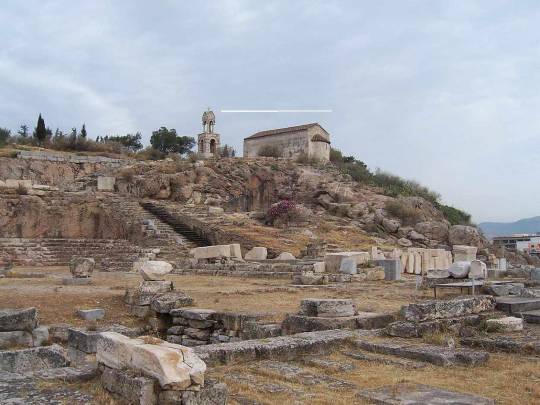
Telesterion
The Telesterion is an ancient Greek building located in Eleusis.
Read more at: https://paganplaces.com/places/telesterion/
0 notes
Text
Holidays 9.20
Holidays
Battle of the Sexes Day
Celebration of Convictions (French Republic)
Constitution Day (Nepal)
Day of Circassians
Eleven Days of Global Unity, Day 10: Disarmament
Farroupilha Revolution (Rio Grande do Sul, Brazil)
Gibberish Day
International Akathisia Awareness Day
International Children’s Growth Awareness Day
International Day of Peace
International Day of University Sport
International Magic Mushroom Day
International NFT Day
International Penile Cancer Awareness Day
Jour de Dessalines (Haiti)
Jump the Shark Day
Liberation Day (East Timor)
Mac Miller Day (Pittsburgh, Pennsylvania)
National Addiction Professionals Day
National Bus Day (Japan)
National Care for Kids Day
National Crime and Intelligence Analyst Appreciation Day
National Equipment Manager Appreciation Day
National Farm Safety Day
National Farting Sound Day
National Fitness Day (UK)
National Gibberish Day
National LGBTQ Veteran’s Day
National Rehabilitation Day
National Science Reading Day
National Silk Day (India)
National Youth Day (Thailand)
Nuakhai (Odisha, India)
Oil Workers’ Day (Azerbaijan)
Purple Bra Day (Australia)
Ragamuffin War (Brazil)
Sambidhaan Diwas (Constitution Day; Nepal)
Unification Day (Firefly)
World Children’s Day (Thüringen, Germany)
World Day for the Freedom of Expression of Thought
World Gynecological Oncology Awareness Day
Food & Drink Celebrations
Make Your Own Junk Food At Home Day
National Fried Rice Day
National Hard Seltzer Day
National Pepperoni Pizza Day
National Punch Day
National Queso Day
National Rum Punch Day
National Sour Beer Day
National String Cheese Day
Rum Punch Day
World Paella Day
3rd Wednesday in September
Banned Websites Awareness Day [3rd Wednesday]
Ember Day (Roman Catholic and Anglican Churches) [Wednesday after 9.14]
Mouth Cancer Awareness Day (Ireland) [3rd Wednesday]
National Attention Deficit Disorder Awareness Day [3rd Wednesday]
National Rehabilitation Day [3rd Wednesday]
National School Backpack Awareness Day [3rd Wednesday]
Quarter Tense (Ireland) [Wednesday after 9.14]
Independence Days
Agber (f.k.a. Kolios; Declared; 1995) [unrecognized]
Austenasia (Declared; 2008) [unrecognized]
Azzurrai (Declared; 2016) [unrecognized]
Marxist Empire (Declared; 2022) [unrecognized]
Mekniy and Lurk (Declared; 2009) [unrecognized]
South Ossetia (from Georgia, 1990) [unrecognized]
Feast Days
Agapitus (Christian; Saint)
Andrew Kim Taegon, Laurent-Marie-Joseph Imbert, and companions (Christian; Korean Martyrs)
Birthday of the Sun (Inca)
Carista (Day of Peace in the Family; Pagan)
Coleridge Patteson (Anglican Communion)
Confucius Day (Confucianism)
Dale Chihuly (Artology)
Eustace (Christian; Saint)
Eustachius and companions (Christian; Martyrs)
Evilasius (Christian; Saint)
Fausta of Cyzicus (Christian; Saint)
Feast of Korean Martyrs (Christian; Martyrs)
Feast of Orlog (Deity of Destiny; Scandinavia)
Feast of Zywie (Goddess of Longevity; Poland)
Genesia (Festival to Honor the Dead, esp. those who died in wars; Ancient Greece)
Glycerius of Milan (Christian; Saint)
Jean-Charles Cornay (Christian; One of Vietnamese Martyrs)
John Coleridge Patteson (commemoration, Anglicanism) (Christian; Saint)
José Maria de Yermo y Parres (Christian; Saint)
Señor Canica (Muppetism)
Sophia Loren Appreciation Day (Pastafarian)
Telesterion begins (7th day of the Eleusinian Mysteries; Ancient Greece)
Théodore Chassériau (Artology)
Theodore, Philippa and companions (Christian; Saint)
Vincent Madelgarius (a..k.a. Maelceadar; Christian; Saint)
Voltaire (Positivist; Saint)
Yummy Kippers Day (Church of the SubGenius)
Lucky & Unlucky Days
Lucky Day (Philippines) [51 of 71]
Prime Number Day: 263 [56 of 72]
Sensho (先勝 Japan) [Good luck in the morning, bad luck in the afternoon.]
Premieres
Alice’s Monkey Business (Disney Cartoon; 1926)
Alice’s Restaurant, by Arlo Guthrie (Album; 1967)
Anasazi Boys, by Neil Gaiman (Novel; 2005)
And Then There Were None, by Agatha Christie (Play; 1943)
Call Me Maybe, by Carla Rae Jepsen (Song; 2011)
The Cosby Show (TV Series; 1984)
Descent into Hell, by Charles Williams (Novel; 1937)
Dirty Deeds Done Dirt Cheap, by AC/DC (Album; 1976)
Downtown Abbey (Film; 2019)
The Fisher King (Film; 1991)
Fore, by Huey Lewis & The News (Album; 1986)
Firefly (TV Series; 2002)
Here Comes the Groom (Film; 1951)
Injun Trouble (WB MM Cartoon; 1969)
Lighthouse Keeping (Disney Cartoon; 1946)
Merlin (TV Series; 2008)
Mike & Molly (TV Series; 2010)
Miss Saigon (Musical Play; 1989)
MTV Cribs (TV Series; 2000)
My Friend Flicka, by Mary O'Hara (Novel; 1941)
My Name is Earl (TV Series; 2005)
New Girl (TV Series; 2011)
Rabbit Seasoning (WB MM Cartoon; 1952)
Ringo the 4th, by Ringo Starr (Album; 1977)
Secretary (Film; 2002)
Spirited Away (Studio Ghibli Anime Film; 2002)
This Is Us (TV Series; 2016)
Travels with Charley: In Search of America, by John Steinbeck (Travelogue; 1961)
Whip-Smart, by Liz Phair (Album; 1994)
Who’s the Boss? (TV Series; 1984)
Window Cleaners (Disney Cartoon; 1940)
Today’s Name Days
Candida, Fausta, Susanne (Austria)
Andrija, Andrijana, Pavao (Croatia)
Oleg (Czech Republic)
Tobias (Denmark)
Kaubi, Kaupo (Estonia)
Varpu, Vaula (Finland)
Davy (France)
Candida, Eustach, Hertha, Susanna (Germany)
Evstathios, Stathis, Theopisti (Greece)
Friderika (Hungary)
Candida, Eustachiusz, Matteo (Italy)
Guntra, Marianna (Latvia)
Eustachijus, Fausta, Tautgirdė, Vainoras (Lithuania)
Tage, Tobias (Norway)
Dionizy, Eustachiusz, Eustachy, Fausta, Faustyna, Filipina, Irena, Oleg, Ostap, Sozant (Poland)
Ľuboslav, Ľuboslava (Slovakia)
Genaro, Jenaro (Spain)
Agda, Elise, Lisa (Sweden)
Oleh (Ukraine)
Eustace, Eustacia, Hailee, Hailey, Haleigh, Haley, Halie, Halle, Hallie, Haylee, Hayley (USA)
Today is Also…
Day of Year: Day 263 of 2024; 102 days remaining in the year
ISO: Day 3 of week 38 of 2023
Celtic Tree Calendar: Muin (Vine) [Day 16 of 28]
Chinese: Month 8 (Xin-You), Day 6 (Xin-Si)
Chinese Year of the: Rabbit 4721 (until February 10, 2024)
Hebrew: 5 Tishri 5784
Islamic: 5 Rabi I 1445
J Cal: 23 Aki; Twosday [23 of 30]
Julian: 7 September 2023
Moon: 28%: Waxing Crescent
Positivist: 11 Shakespeare (10th Month) [Voltaire]
Runic Half Month: Ken (Illumination) [Day 9 of 15]
Season: Summer (Day 91 of 94)
Zodiac: Virgo (Day 30 of 32)
0 notes
Text
Holidays 9.20
Holidays
Battle of the Sexes Day
Celebration of Convictions (French Republic)
Constitution Day (Nepal)
Day of Circassians
Eleven Days of Global Unity, Day 10: Disarmament
Farroupilha Revolution (Rio Grande do Sul, Brazil)
Gibberish Day
International Akathisia Awareness Day
International Children’s Growth Awareness Day
International Day of Peace
International Day of University Sport
International Magic Mushroom Day
International NFT Day
International Penile Cancer Awareness Day
Jour de Dessalines (Haiti)
Jump the Shark Day
Liberation Day (East Timor)
Mac Miller Day (Pittsburgh, Pennsylvania)
National Addiction Professionals Day
National Bus Day (Japan)
National Care for Kids Day
National Crime and Intelligence Analyst Appreciation Day
National Equipment Manager Appreciation Day
National Farm Safety Day
National Farting Sound Day
National Fitness Day (UK)
National Gibberish Day
National LGBTQ Veteran’s Day
National Rehabilitation Day
National Science Reading Day
National Silk Day (India)
National Youth Day (Thailand)
Nuakhai (Odisha, India)
Oil Workers’ Day (Azerbaijan)
Purple Bra Day (Australia)
Ragamuffin War (Brazil)
Sambidhaan Diwas (Constitution Day; Nepal)
Unification Day (Firefly)
World Children’s Day (Thüringen, Germany)
World Day for the Freedom of Expression of Thought
World Gynecological Oncology Awareness Day
Food & Drink Celebrations
Make Your Own Junk Food At Home Day
National Fried Rice Day
National Hard Seltzer Day
National Pepperoni Pizza Day
National Punch Day
National Queso Day
National Rum Punch Day
National Sour Beer Day
National String Cheese Day
Rum Punch Day
World Paella Day
3rd Wednesday in September
Banned Websites Awareness Day [3rd Wednesday]
Ember Day (Roman Catholic and Anglican Churches) [Wednesday after 9.14]
Mouth Cancer Awareness Day (Ireland) [3rd Wednesday]
National Attention Deficit Disorder Awareness Day [3rd Wednesday]
National Rehabilitation Day [3rd Wednesday]
National School Backpack Awareness Day [3rd Wednesday]
Quarter Tense (Ireland) [Wednesday after 9.14]
Independence Days
Agber (f.k.a. Kolios; Declared; 1995) [unrecognized]
Austenasia (Declared; 2008) [unrecognized]
Azzurrai (Declared; 2016) [unrecognized]
Marxist Empire (Declared; 2022) [unrecognized]
Mekniy and Lurk (Declared; 2009) [unrecognized]
South Ossetia (from Georgia, 1990) [unrecognized]
Feast Days
Agapitus (Christian; Saint)
Andrew Kim Taegon, Laurent-Marie-Joseph Imbert, and companions (Christian; Korean Martyrs)
Birthday of the Sun (Inca)
Carista (Day of Peace in the Family; Pagan)
Coleridge Patteson (Anglican Communion)
Confucius Day (Confucianism)
Dale Chihuly (Artology)
Eustace (Christian; Saint)
Eustachius and companions (Christian; Martyrs)
Evilasius (Christian; Saint)
Fausta of Cyzicus (Christian; Saint)
Feast of Korean Martyrs (Christian; Martyrs)
Feast of Orlog (Deity of Destiny; Scandinavia)
Feast of Zywie (Goddess of Longevity; Poland)
Genesia (Festival to Honor the Dead, esp. those who died in wars; Ancient Greece)
Glycerius of Milan (Christian; Saint)
Jean-Charles Cornay (Christian; One of Vietnamese Martyrs)
John Coleridge Patteson (commemoration, Anglicanism) (Christian; Saint)
José Maria de Yermo y Parres (Christian; Saint)
Señor Canica (Muppetism)
Sophia Loren Appreciation Day (Pastafarian)
Telesterion begins (7th day of the Eleusinian Mysteries; Ancient Greece)
Théodore Chassériau (Artology)
Theodore, Philippa and companions (Christian; Saint)
Vincent Madelgarius (a..k.a. Maelceadar; Christian; Saint)
Voltaire (Positivist; Saint)
Yummy Kippers Day (Church of the SubGenius)
Lucky & Unlucky Days
Lucky Day (Philippines) [51 of 71]
Prime Number Day: 263 [56 of 72]
Sensho (先勝 Japan) [Good luck in the morning, bad luck in the afternoon.]
Premieres
Alice’s Monkey Business (Disney Cartoon; 1926)
Alice’s Restaurant, by Arlo Guthrie (Album; 1967)
Anasazi Boys, by Neil Gaiman (Novel; 2005)
And Then There Were None, by Agatha Christie (Play; 1943)
Call Me Maybe, by Carla Rae Jepsen (Song; 2011)
The Cosby Show (TV Series; 1984)
Descent into Hell, by Charles Williams (Novel; 1937)
Dirty Deeds Done Dirt Cheap, by AC/DC (Album; 1976)
Downtown Abbey (Film; 2019)
The Fisher King (Film; 1991)
Fore, by Huey Lewis & The News (Album; 1986)
Firefly (TV Series; 2002)
Here Comes the Groom (Film; 1951)
Injun Trouble (WB MM Cartoon; 1969)
Lighthouse Keeping (Disney Cartoon; 1946)
Merlin (TV Series; 2008)
Mike & Molly (TV Series; 2010)
Miss Saigon (Musical Play; 1989)
MTV Cribs (TV Series; 2000)
My Friend Flicka, by Mary O'Hara (Novel; 1941)
My Name is Earl (TV Series; 2005)
New Girl (TV Series; 2011)
Rabbit Seasoning (WB MM Cartoon; 1952)
Ringo the 4th, by Ringo Starr (Album; 1977)
Secretary (Film; 2002)
Spirited Away (Studio Ghibli Anime Film; 2002)
This Is Us (TV Series; 2016)
Travels with Charley: In Search of America, by John Steinbeck (Travelogue; 1961)
Whip-Smart, by Liz Phair (Album; 1994)
Who’s the Boss? (TV Series; 1984)
Window Cleaners (Disney Cartoon; 1940)
Today’s Name Days
Candida, Fausta, Susanne (Austria)
Andrija, Andrijana, Pavao (Croatia)
Oleg (Czech Republic)
Tobias (Denmark)
Kaubi, Kaupo (Estonia)
Varpu, Vaula (Finland)
Davy (France)
Candida, Eustach, Hertha, Susanna (Germany)
Evstathios, Stathis, Theopisti (Greece)
Friderika (Hungary)
Candida, Eustachiusz, Matteo (Italy)
Guntra, Marianna (Latvia)
Eustachijus, Fausta, Tautgirdė, Vainoras (Lithuania)
Tage, Tobias (Norway)
Dionizy, Eustachiusz, Eustachy, Fausta, Faustyna, Filipina, Irena, Oleg, Ostap, Sozant (Poland)
Ľuboslav, Ľuboslava (Slovakia)
Genaro, Jenaro (Spain)
Agda, Elise, Lisa (Sweden)
Oleh (Ukraine)
Eustace, Eustacia, Hailee, Hailey, Haleigh, Haley, Halie, Halle, Hallie, Haylee, Hayley (USA)
Today is Also…
Day of Year: Day 263 of 2024; 102 days remaining in the year
ISO: Day 3 of week 38 of 2023
Celtic Tree Calendar: Muin (Vine) [Day 16 of 28]
Chinese: Month 8 (Xin-You), Day 6 (Xin-Si)
Chinese Year of the: Rabbit 4721 (until February 10, 2024)
Hebrew: 5 Tishri 5784
Islamic: 5 Rabi I 1445
J Cal: 23 Aki; Twosday [23 of 30]
Julian: 7 September 2023
Moon: 28%: Waxing Crescent
Positivist: 11 Shakespeare (10th Month) [Voltaire]
Runic Half Month: Ken (Illumination) [Day 9 of 15]
Season: Summer (Day 91 of 94)
Zodiac: Virgo (Day 30 of 32)
0 notes
Note
I admire how you are consistently abelt p get at minimum dozens of notes on the most niche fucking jokes I've ever heard
My secret is that the joke itself is not the joke. I specialize in jokes that are purposefully designed to make people go "hold on lemme Google something" so I can send them down the most bizarre Wikipedia rabbit hole possible. Watch this:
"Me and the girls getting [REDACTED] in the Telesterion"
2K notes
·
View notes
Text
Are Mundal – Kreis (EP – Telesterion Records)
http://dlvr.it/SrbC1l
0 notes
Text
MISTERIOS DE ELEUSIS

Los Misterios de Eleusis eran una festividad ateniense que se celebraba anualmente en el santuario de Deméter y de Perséfone, ubicado en Eleusis, una pequeña localidad de la región del Ática. Este festival, plasmado en el Himno homérico a Deméter, se documenta ya durante la época arcaica (s. VIII-VI a.C.), cuando los Misterios aparecen en el calendario de festividades atenienses. ¿En qué consistían estos “misterios”?
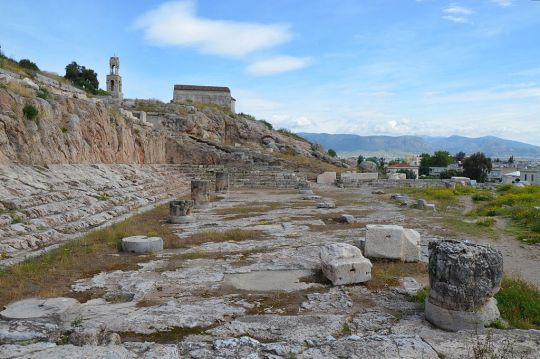
El festival duraba varios días y comenzaba oficialmente el día 15 del Boedromión, mes que en el calendario ático corresponde con el inicio del otoño, cuando los jóvenes que se iban a iniciar en los Misterios se reunían en el ágora y el hierofante, es decir, el sacerdote de Eleusis que presidía estos ritos, anunciaba que estaba prohibida la participación de quienes no hablasen griego y también la de aquellos impuros por asesinato. Al día siguiente, los iniciados se bañaban en el mar del puerto ateniense de Falero junto con un lechón que luego era sacrificado, siendo la última comida de estos jóvenes antes de iniciar un periodo de ayuno de tres días.
Pasado este periodo, el día 19 se conducía la procesión, en cuya cabeza iba una estatua de Iaco, identificado con Dioniso, desde Atenas hasta Eleusis, como queda reflejado en el Pinax de Ninnion. Durante este trayecto, cuando cruzaban el puente del río Céfiso, lanzaban insultos obscenos para alejar a los malos espíritus, una práctica que se encuentra en los orígenes del yambo, un tipo de poesía que toma su nombre de Yambe, mujer que consiguió con su humor hacer reír por primera a Deméter después de que Hades secuestrara a su hija Perséfone. Cuando llegaban a Eleusis, ya de noche, los iniciados rompían el ayuno y bebían el llamado “ciceón”, una mezcla de cebada, menta y agua. A partir de aquí, se desconoce realmente lo que hacían una vez que entraban dentro de los muros del santuario, llevándose a cabo la iniciación en una sala llamada Telesterion, cuyos restos se muestran en la primera imagen. Por tanto, si los rituales que se llevaban a cabo antes de llegar a Eleusis eran comúnmente conocidos, los que se realizaban en la propia Eleusis, en cambio, se mantenían en absoluto secreto.

Los Misterios de Eleusis continuaron celebrándose en época romana, participando en ellos las élites que, además de latín, hablaban griego, desde oradores como Cicerón hasta emperadores como Marco Aurelio. Sin embargo, los Misterios empezaron a declinar durante el s. III y IV d.C., sobre todo cuando Constantino permitió el cristianismo en el Imperio.
¿Serías capaz de responder estas preguntas? ¡Mira nuestra siguiente publicación a través de las etiquetas o mediante el link que está en los comentarios!
Bibliografía.
-Scott, M. (2017). Delphic oracle. Oxford Classical Dictionary. https://doi.org/10.1093/acrefore/9780199381135.013.2080
0 notes
Link
0 notes
Photo
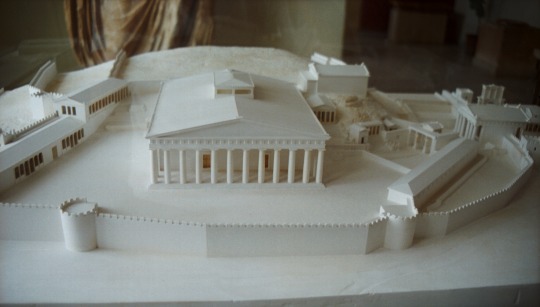

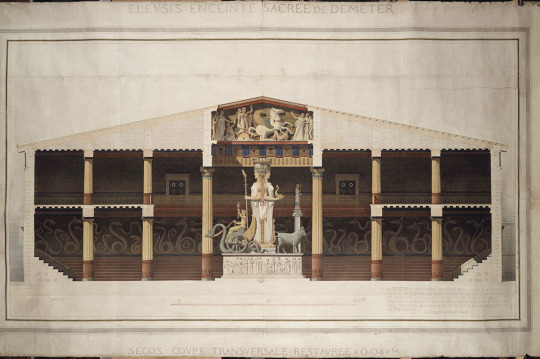

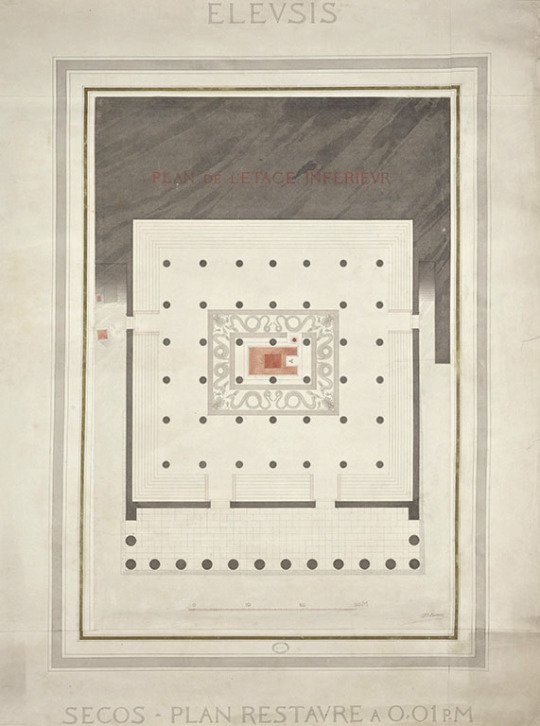

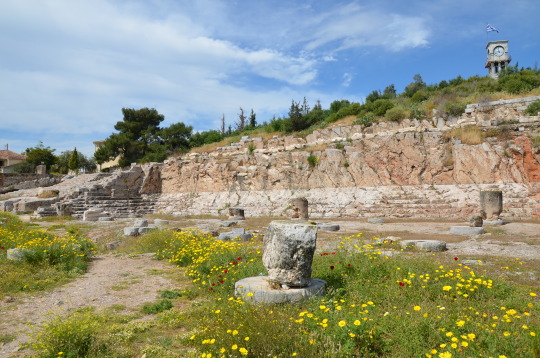
Telesterion
Eleusis, Attica, Greece
5th century BCE - 170 CE
The Telesterion ("Initiation Hall" from Gr. τελείω, "to complete, to fulfill, to consecrate, to initiate") was a great hall and sanctuary in Eleusis, one of the primary centers of the Eleusinian Mysteries. Devoted to Demeter and Persephone, these initiation ceremonies were the most sacred and ancient of all the religious rites celebrated in Greece.
The Athenians used several calendars, each for different purposes. The festival of Eleusinia was celebrated each year in Eleusis and Athens for nine days from the 15th to the 23rd of the month of Boedromion (in September or October of the Gregorian calendar); because the festival calendar had 12 lunar months, the celebrations were not strictly calibrated to a year of 365 days. During the festival, Athens was crowded with visitors. As the climax of the ceremonies at Eleusis, the initiates entered the Telesterion where they were shown the sacred relics of Demeter and the priestesses revealed their visions of the holy night (probably a fire that represented the possibility of life after death). This was the most secretive part of the Mysteries and those who had been initiated were forbidden to ever speak of the events that took place in the Telesterion. If still in use by the 4th-century, the temple would have been closed during the persecution of pagans in the late Roman Empire, when all non-Christian sanctuaries was ordered closed by law initiated by the Christian emperors.
The site of the Telesterion is believed to have had some temple since the 7th century BCE, or the time of the Homeric Hymn to Demeter one of 33 Homeric Hymns (650-550 BCE); the Telesterion had ten different building phases. It was destroyed by the Persians after the Battle of Thermopylae, when the Athenians withdrew to Salamis in 480 BCE and all of Boeotia and Attica fell to the Persian army, who captured and burnt Athens. After the defeat of the Persians, the Telesterion was rebuilt some time later by Pericles. At some point in the 5th century BCE, Iktinos, the great architect of the Parthenon, built the Telesterion big enough to hold thousands of people. In about 318 BCE, Philon added a portico with twelve Doric columns. In CE 170, during the rule of Roman emperor Marcus Aurelius, an ancient tribe called the Costoboci launched an invasion of Roman territory south of the Danube, entering Thracia and ravaging the provinces of Macedonia and Achaea (Greece). The Costoboci reached as far south as Eleusis, where they destroyed the Telesterion. The emperor responded by despatching general Vehilius Gratus Iulianus to Greece with emergency reinforcements, who eventually defeated the Costoboci. Marcus Aurelius then had the Telesterion rebuilt. In 396 CE, the forces of Alaric the Visigoth invaded the Eastern Roman Empire and ravaged Attica, destroying the Telesterion, which was never to be rebuilt.
#art#Architecture#travel#history#Telesterion#eleusis#Attica#mysteries#greek#greek art#Greek architecture#Greek Mythology#demeter#persephone#Eleusinian Mysteries#doric#Greek Temple#5 bce
447 notes
·
View notes